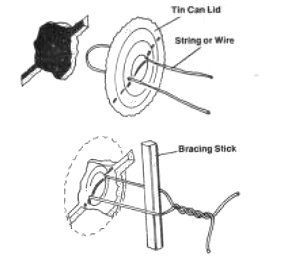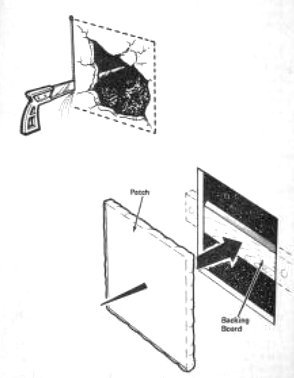Holes and cracks in wallboard-small or large–are easy to repair, and the finished patch will be almost invisible.
Patching Drywall Holes
Holes less than 3 inches in diameter can be backed and filled.
Remove any crumbling plaster or paper from the edges of the hole and measure it across.
To make a backing, use a clean washed in hot, soapy water tin can lid that is at least 1 inches bigger than the hole.
Punch two holes at the center of the lid with a hammer and a nail, and thread a foot-long piece of string or wire through the holes
Place the lid over the hole and outline its edge on the wall with a pencil.
With a keyhole saw, cut a narrow slit centered on the hole in the wall, a little longer than the diameter of the tin can lid
Choose a stick of scrap wood at least 4 inches longer than the diameter of the hole, and set it aside to use as a brace.
Wet the edges of the hole and the slit with a sponge dipped in water.
Mix plaster of paris according to the manufacturer’s directions
Holding both ends of the string threaded through the can lid, slide the lid carefully through the slitin the wall.
Pull the ends of the string to bring the lid flat against the back of the wall.
While holding the ends of the string with one hand, fill the hole and the slit with plaster of paris, smoothing plaster carefully against the tin can lid.
Leave the surface of the patch indented slightly below the wall surface
Still holding the ends of the string sticking out from the plaster, set the bracing stick over the hole, at right angles to the filled-in slit and directly between the two strings.
Tie the two ends of the string firmly over the stick, pulling the knot tight so that the tin can lid inside the wall and the stick outside are both securely held.
Let the patch dry for 24 hours
When the plaster is completely dry, cut the string and remove the stick.
Pull gently on one end of the string if it comes loose, pull the string carefully out of the wall.
If the string doesn’t pull loose, cut the ends flush with the new plaster.
Don’t try to force the string or you may break the patch

For small holes, back the opening with a tin can lid Use wire or string and a bracing stick to hold the din position.
Fill the opening with plaster of paris.
Finish the job by applying another coat of plaster of paris to level the patch.
Let it dry completely and sand it smooth with fine-grit sandpaper repeat if necessary.
Prime the patched spot, let it dry for several hours, and then repaint the entire wall.
To patch a large hole or badly damaged area, cut a square or rectangular piece of wallboard slightly larger than the hole.
Set this patch flat on the wall over the hole and trace carefully around it with a pencil.
Set the patch aside and cut out the traced area; use a utility knife to score the paper before cutting away the damaged wallboard.
Remove the sawed-out piece from the wall
Measure the opening across its longest dimension.
To back a small patch, use a piece of thin scrap wood about 4 inches longer than the hole’s longest dimension.
Apply contact cement to the ends of the length of wood and to the back of the wall where the brace will bridge the hole.
Let the cement dry.
Insert the brace sideways into the hole, position it so that the cemented areas match, and set the brace firmly in place, flat against the inside of the wall.
To brace a large patch, use a lightweight board about 6 inches longer than the opening.
Slide the board into the hole and hold it flat against the inside of the wall.
To hold it in place, drive countersunk screws through the wall and into the ends of the board.
Tighten the screws until the heads are below the surface of the wall
Spread patching plaster over the exposed side of the secured brace, and cover the edges of the plasterboard patch with the compound.
Set the patch carefully in place, making sure it is flush with the wall surface.
Hold it in place for a few minutes while the patching plaster hardens.
Complete the job by plastering over the outlines of the patch and the exposed screw heads.
Let dry completely and sand the area smooth: repeat it necessary.
Prime the patched area, let dry for several hours, and repaint the entire wall.
How to Patch Drywall Video
If you’re not interested in reading this article and would rather watch video instruction, here are a couple helpful videos on repairing drywall cracks and holes:
Patching Cracks
Small cracks in plaster can be fixed with routine pre-painting work, but big cracks demand more drastic measures
Large cracks must be scraped and cleaned before repairing.
With the pointed end of a can Opener or other suitable tool remove loose plaster from the crack.
Turn the point of the opener sideways each way to widen the opening and undercut it slightly.
Vacuum the crack to remove loose plaster and dust.
Mix plaster of paris with water to a thick paste, being careful to remove all lumps.
It hardens quickly, so mix only enough to fill the crack you’re working on
Paint the crack thoroughly with water, using firm brush strokes along the crack to wet the plaster inside to its full depth.
Apply plaster to the crack with a putty knife or broad paint scraper, forcing plaster in to the full depth of the crack.
Smooth the surface of the crack to remove excess plaster
Let the new plaster dry completely preferably.
Overnight it will turn bright white as it dries Sand the patched area with fine-grit sandpaper to smooth and level it, then repeat the wetting and filling procedure, if necessary.
Let the plaster dry again and sand it smooth.
Before painting the wall prime the patch with a light coat of paint.
Before patching a large crack in an outside wall, look for the cause of the damage.
If there is a structural problems cracked foundation, for instance-it must be corrected before you make repairs.
Full wide openings as described earlier.
Break out any loose chunks of plaster, undercut the crack with a can opener or other suitable tool, and vacuum to remove all dust.
Wet the opening thoroughly on both sides, as far in as you can reach with the paintbrush.
Mix enough plaster of paris to fill the opening completely.

To brace a large patch, screw a board inside the wall tightening the screws until the heads are countersunk.
Using a putty knife or a small trowel, fill the opening with plaster, pressing plaster all the way into the crack.
Smooth the surface with a broad paint scraper.
Let the plaster dry for at least 24 hours, moisten it with a wet paintbrush, and fill the crack again to level the surface.
Let it dry for 24 hours, and then sand it smooth.
Before painting the wall, prime the patch with a light coat of paint

